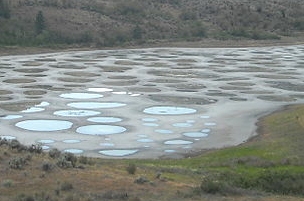
June Editorial
The Spotted Lake

June Editorial
The Spotted Lake
|
It has been used as a munitions resource, a holy place of peace, and a combat hospital. Yet the site - known as ‘Kliluk’ to the native peoples of the Okanagan Valley in western Canada - is unique because of its lake. The English name for it is ’Spotted Lake’, because, well, it is.
|
The Spotted Lake is revered by the local first nations tribes, and for others it is a geological curiosity like no other. The Okanagan represents the very far northern arm of America’s Sonora Desert, and as is often the case with deserts, the summers get both very hot and dry. So during summer the water in the lake evaporates almost completely. This leaves the lake bed spotted with large pools of various shades of blue, green, yellow and orange. The effect is startling, almost bizarre, as though someone had put a huge art deco design in the middle of a barren valley of sagebrush and pine. |
|
|
This odd manifestation is because the lake contains high concentrations of numerous minerals. In fact, Kliluk is one of the most mineral-rich bodies of water on Earth. Depending on the composition of the mineral mixture in different parts of the lake in any given year, the evaporating water will leave well-defined spots of several metres across in distinct colours. The lake is about 9km from the town of Osyoos in British Columbia. At 15.37 hectares (38 acres) it is small in comparison to some of the larger lakes of the region. Nearby lake Okanagan is 351 square kilometers, and over a kilometre deep in places. Yet because Kliluk is relatively small, the mineral concentration is correspondingly dense. The lake contains the world's highest concentration of magnesium sulfate, calcium, sodium sulfate as well as other minerals of smaller quantities including silver and titanium. From ancient times the local native tribes have regarded the late as a holy place with healing properties. Indeed, during wars between different tribes, the fighting sides would have a truce so that warriors could go and wash their wounds in the lake. The fact that the lake was sacred received less attention that it should during the First World War, when the lake was mined for minerals to be used for manufacturing ammunition. Not only was the uniqueness of this geological formation disregarded, but local tribesmen were distressed to see their place of peace used to manufacture munitions of war. Subsequent decades saw a concentrated effort for the first nations people to bring the lake back into their custody. The authorities were increasingly sympathetic, and today the lake is jointly owned by the First Nation of the Okanagan and the Crown. The lake is a popular tourist attraction, but at present tourists are not actually allowed at the lake side for fear that they may inadvertently disturb the spots. There are plans to build a walkway so that visitors can get close to inspect the spots (which form a different configuration every year) As for now, during the summer months (from June through September) the spots on Kliluk can be easily observed from local highway (Hwy 3) as they start to form. | |
| _______________________________ | ||||
| Home | | | Shopping | | | Database |
© Biscuit Software 2004-2015
All rights reserved